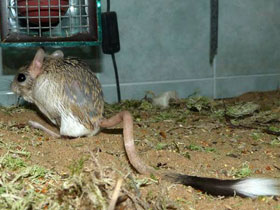The lesser jerboa (Jaculus jaculus)
The lesser jerboa (Jaculus jaculus) is a small rodent of Africa and the Middle East. Its diet consists mainly of seeds and grasses.
Small rodents of the same family Dipodidae are often mistakenly called gerbils, but the name of these rodents is the Mongolian gerbil (Meriones unguiculatus), and it is usually the latter that is used as a pet.
Habitat
Jaculus jaculus is distributed in northeastern Africa and adjacent parts of western Asia (Sahara from the Mediterranean Sea to southern Mauritania, Timbuktu, Lake Chad, Sudan and Somalia; Palestine; Syria; Iraq; Arabian Peninsula).
Appearance
Its body length ranges from 100 to 120 mm. The muzzle of the Egyptian gopher tortoise is shortened. Its metacarpal is well defined; its ears are relatively long. The tail is about 1.5 times longer than the body, not thickened, with a well-developed flag at the end. The claws on the forelimbs are sickle-curved. The hind limbs are three-toed. The claws on the hind limbs are straight and sharp. The middle toe of the hind limb is slightly longer than the length of the middle claw.
The hair cover of Jaculus jaculus is dense and soft. The head and back are covered with fur from pale sandy-yellow to dark ochre-brown with indistinct dark longitudinal jetting. Abdomen white. Bristle on foot white, brownish or black.
Behaviour and diet
This animal is active mainly at night, while it spends the day in burrows. The diet of Jaculus jaculus is based on seeds, roots and green parts of various plants, as well as insects. The hottest summer months are spent in hibernation.
In the wild, Jaculus jaculus does not drink water at all
This little-studied species lives in one of the most hostile deserts on the planet. It doesn't drink at all and gets enough moisture from its food. This small creature can walk up to 10 km a day in search of food and can jump a metre in height and three metres in length.
Breeding
Not much is known about the reproduction of Jaculus jaculus. It breeds at least twice a year: in June-July and October-December. The female gives birth to 4-5 cubs, which become independent at 8-10 weeks of age.











































